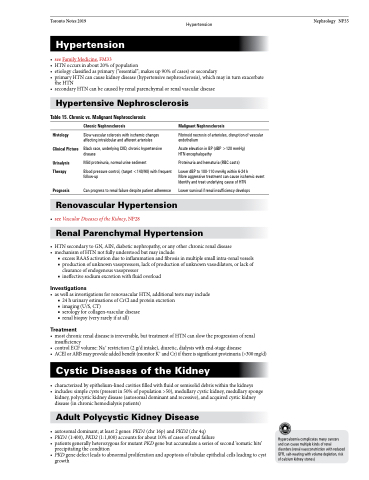Page 735 - TNFlipTest
P. 735
Toronto Notes 2019 Hypertension Hypertension
• seeFamilyMedicine,FM33
• HTNoccursinabout20%ofpopulation
• etiologyclassifiedasprimary(“essential”;makesup90%ofcases)orsecondary
• primaryHTNcancausekidneydisease(hypertensivenephrosclerosis),whichmayinturnexacerbate
the HTN
• secondaryHTNcanbecausedbyrenalparenchymalorrenalvasculardisease
Hypertensive Nephrosclerosis
Nephrology NP35
Table 15. Chronic vs. Malignant Nephrosclerosis
Histology Clinical Picture
Urinalysis Therapy
Prognosis
Chronic Nephrosclerosis
Slow vascular sclerosis with ischemic changes affecting intralobular and afferent arterioles
Black race, underlying CKD, chronic hypertensive disease
Mild proteinuria, normal urine sediment
Blood pressure control, (target <140/90) with frequent follow-up
Can progress to renal failure despite patient adherence
Malignant Nephrosclerosis
Fibrinoid necrosis of arterioles, disruption of vascular endothelium
Acute elevation in BP (dBP >120 mmHg) HTN encephalopathy
Proteinuria and hematuria (RBC casts)
Lower dBP to 100-110 mmHg within 6-24 h
More aggressive treatment can cause ischemic event Identify and treat underlying cause of HTN
Lower survival if renal insufficiency develops
Renovascular Hypertension
• seeVascularDiseasesoftheKidney,NP28
Renal Parenchymal Hypertension
• HTNsecondarytoGN,AIN,diabeticnephropathy,oranyotherchronicrenaldisease • mechanismofHTNnotfullyunderstoodbutmayinclude:
■ excess RAAS activation due to inflammation and fibrosis in multiple small intra-renal vessels
■ production of unknown vasopressors, lack of production of unknown vasodilators, or lack of
clearance of endogenous vasopressor
■ ineffectivesodiumexcretionwithfluidoverload
Investigations
• aswellasinvestigationsforrenovascularHTN,additionaltestsmayinclude ■ 24 h urinary estimations of CrCl and protein excretion
■ imaging (U/S, CT)
■ serology for collagen-vascular disease
■ renal biopsy (very rarely if at all)
Treatment
• mostchronicrenaldiseaseisirreversible,buttreatmentofHTNcanslowtheprogressionofrenal insufficiency
• control ECF volume: Na+ restriction (2 g/d intake), diuretic, dialysis with end-stage disease
• ACEI or ARB may provide added benefit (monitor K+ and Cr) if there is significant proteinuria (>300 mg/d)
Cystic Diseases of the Kidney
• characterizedbyepithelium-linedcavitiesfilledwithfluidorsemisoliddebriswithinthekidneys
• includes:simplecysts(presentin50%ofpopulation>50),medullarycystickidney,medullarysponge
kidney, polycystic kidney disease (autosomal dominant and recessive), and acquired cystic kidney disease (in chronic hemodialysis patients)
Adult Polycystic Kidney Disease
• autosomaldominant;atleast2genes:PKD1(chr16p)andPKD2(chr4q)
• PKD1(1:400),PKD2(1:1,000)accountsforabout10%ofcasesofrenalfailure
• patients generally heterozygous for mutant PKD gene but accumulate a series of second ‘somatic hits’
precipitating the condition
• PKDgenedefectleadstoabnormalproliferationandapoptosisoftubularepithelialcellsleadingtocyst
growth
Hypercalcemia complicates many cancers and can cause multiple kinds of renal disorders (renal vasoconstriction with reduced GFR, salt-wasting with volume depletion, risk of calcium kidney stones)


